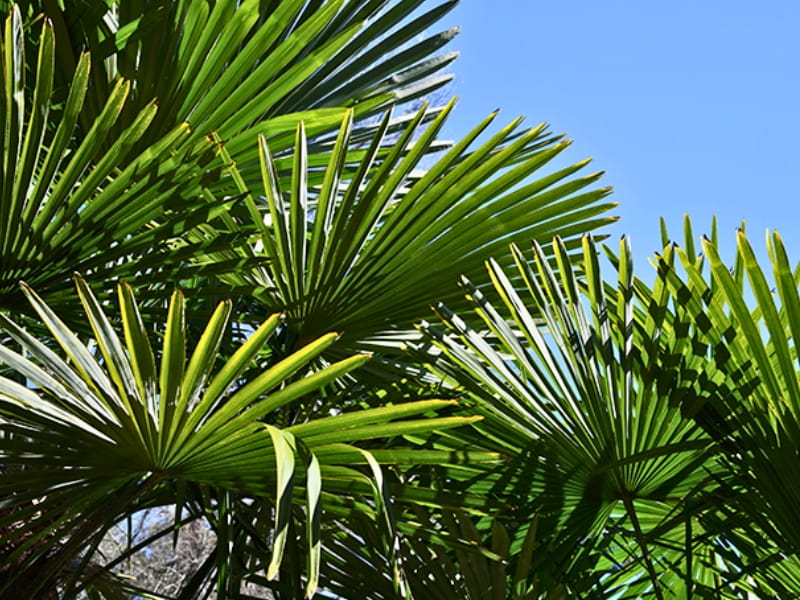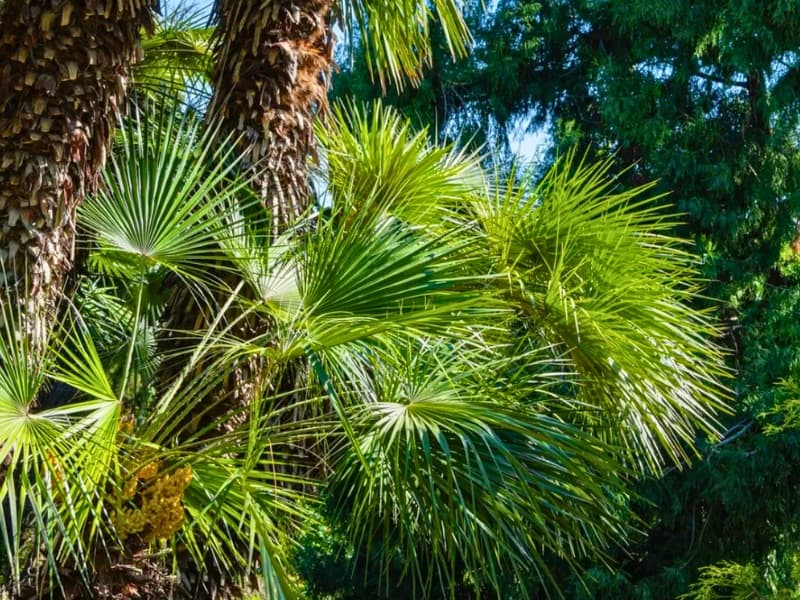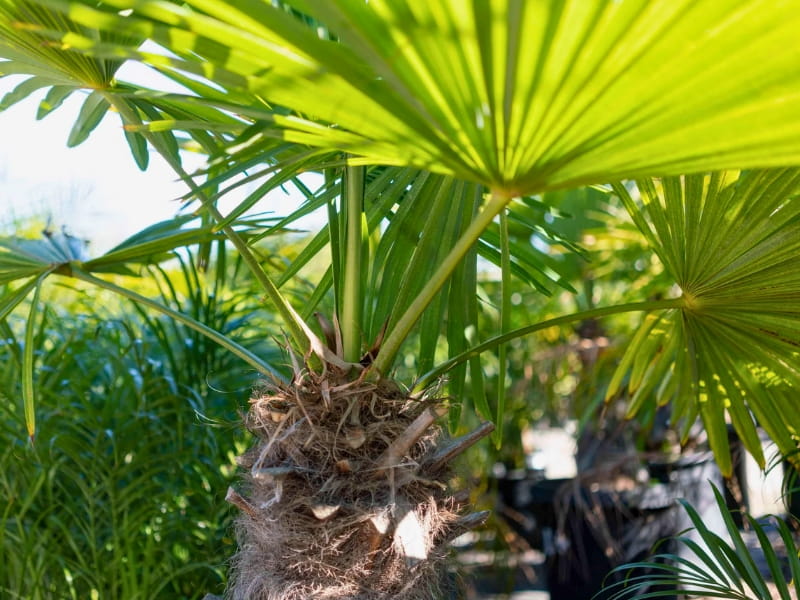Chinese Windmill Palm ( Trachycarpus fortunei ), also known as Chusan Palm or Windmill Palm, is a remarkably hardy and visually striking palm species that brings an exotic touch to temperate landscapes. This evergreen fan palm, botanically named Trachycarpus fortunei, is celebrated for its tolerance to cold and its distinctive, fibrous trunk.
This comprehensive guide will cover the palm’s characteristics, hardiness, cultivation tips, potential problems, and more, providing a valuable resource for both novice and experienced gardeners. Keep reading to unlock the secrets of successfully growing and enjoying this beautiful palm in your own garden or landscape. You may also want to learn how to troubleshoot issues with the plant, and that is included also.

Chinese Windmill Palm: An In-Depth Guide to Care, Characteristics, and Hardiness
The Chinese Windmill Palm (Trachycarpus fortunei) presents a unique blend of tropical aesthetics and cold-weather resilience. It is a popular choice for gardeners in a wide range of climates. This section provides a foundational understanding of the palm, its key features, and its overall suitability for various landscapes. We will start at the very beginning and describe this attractive palm, providing detailed, easy-to-follow, and practical information.
| Common Name(s) | Chinese Windmill Palm, Windmill Palm, Chusan Palm |
| Botanical Name | Trachycarpus fortunei |
| Family | Arecaceae (Palm Family) |
| Genus | Trachycarpus |
| Species | fortunei |
| Origin | Central and Eastern China, Myanmar, Northern India |
| Native | China |
| Life Cycle | Perennial |
| Plant Type | Palm, Evergreen |
| Hardiness Zone(s) | 7b-11 (with some protection in colder areas) |
| Sunlight | Full Sun to Partial Shade |
| Maintenance | Low |
| Water | Moderate; Drought-tolerant once established |
| Drainage | Well-Drained |
| Spacing | 8-10 feet (2.4-3 meters) apart |
| Flowering Period | Spring (for female plants) |
| Height | 20-40 feet (6-12 meters) average; can reach greater heights |
| Growth Rate | Slow to Moderate (1-2 feet/30-60 cm per year) |
| Flower Color | Yellow (small flowers on female plants) |
| Fruit Color (Mature) | Bluish-black or dark purple |
| Stem Color (Trunk) | Brown, covered in dense, fibrous leaf bases |
| Flower Benefit | Produces fruit on female plants (requires male plant for pollination) |
| Garden Style | Tropical, Mediterranean, Urban, Specimen, Accent |
| Uses | Ornamental, Landscape, Container, Erosion Control, (Traditionally: fiber, building materials) |
| Salt Tolerance | Moderate |
| Soil pH | Adaptable to a wide range. |
| Deer Resistance | Moderate |
| Notable Feature | Exceptional cold hardiness for a palm |
Origin and History
The Chinese Windmill Palm’s story began centuries ago in the temperate, mountainous regions of central and eastern China, extending to parts of Myanmar and northern India. The palm thrived in cool, moist forests, often at higher elevations. This natural habitat explains its remarkable tolerance for cold temperatures and even snow, a characteristic that sets it apart from most other palm species.
The palm’s introduction to the Western world is largely credited to Robert Fortune, a Scottish botanist who extensively explored China in the mid-19th century. Fortune, working for the Royal Horticultural Society, sent specimens of the palm back to Europe, where it quickly gained popularity for its exotic appearance and unexpected hardiness. The palm was subsequently named Trachycarpus fortunei in his honor.
Over the years, the Chinese Windmill Palm has spread globally, becoming a staple in gardens and landscapes in many temperate regions, including parts of Europe, North America, and Australasia. Its adaptability to various soil types and its ability to withstand urban conditions have further contributed to its widespread appeal.
Botanical Description and Characteristics
The Chinese Windmill Palm is instantly recognizable by its unique, fibrous trunk. This “hairy” trunk is formed by the persistent leaf bases that remain attached to the stem even after the leaves have died. These fibers create a thick, insulating layer that protects the palm from cold temperatures. The trunk typically grows to a height of 20 to 40 feet, although some specimens can reach even greater heights in ideal conditions.
The palm’s crown consists of large, fan-shaped leaves (palmate) that can span up to 4 feet across. These leaves are deeply divided into numerous segments, giving them a delicate, lacy appearance. The leaves are typically a vibrant green color, although some variations may exhibit a bluish or silvery tinge.
Trachycarpus fortunei is a dioecious species, meaning that individual plants are either male or female. Female palms produce small, yellow flowers in spring, followed by clusters of bluish-black, kidney-shaped fruits. While these fruits are not considered edible, they add to the palm’s ornamental value.
Here’s a table summarizing the key characteristics:
| Feature | Description |
|---|---|
| Botanical Name | Trachycarpus fortunei |
| Common Names | Chinese Windmill Palm, Chusan Palm, Windmill Palm |
| Family | Arecaceae (Palm Family) |
| Origin | Central and Eastern China, Myanmar, Northern India |
| Growth Habit | Single-trunked, evergreen palm |
| Height | Typically 20-40 feet (can reach greater heights in ideal conditions) |
| Trunk | Covered in dense, fibrous leaf bases, giving it a “hairy” appearance |
| Leaves | Large, fan-shaped (palmate), deeply divided into segments, vibrant green color (may have bluish or silvery tinge) |
| Flowers | Small, yellow flowers in spring (on female plants) |
| Fruit | Bluish-black, kidney-shaped fruits (on female plants) |
| Hardiness Zones | USDA Zones 7b-11 (can tolerate temperatures down to 5°F (-15°C) with protection) |
| Sun Exposure | Full sun to partial shade |
| Soil Requirements | Well-drained soil, adaptable to various soil types (sandy, loamy, clay) |
| Water Requirements | Moderate, drought-tolerant once established |
| Salt Tolerance | Moderate |

Hardiness and Cold Tolerance
One of the most compelling attributes of the Chinese Windmill Palm is its exceptional cold hardiness. This palm can withstand temperatures down to 5°F (-15°C) when mature and properly protected. This makes it suitable for cultivation in USDA Hardiness Zones 7b through 11. Younger palms, however, are more vulnerable to cold damage and may require additional protection in colder climates.
The palm’s hardiness is largely attributed to its fibrous trunk, which acts as a natural insulator, protecting the sensitive growing point (the apical meristem) from freezing temperatures. The leaves can also tolerate some frost and snow, although prolonged exposure to extreme cold can cause browning or dieback.
It’s important to note that hardiness can vary depending on several factors, including the palm’s overall health, microclimate conditions, and the duration and severity of the cold. Providing winter protection, such as wrapping the trunk with burlap or applying a thick layer of mulch around the base, can significantly increase the palm’s chances of survival in colder regions. Gardencenterpoint.com recommends these protective measures, especially for newly planted or younger palms.
Cultivating Your Chinese Windmill Palm: Planting, Care, and Maintenance
Growing a Chinese Windmill Palm can be a rewarding experience, provided you understand its basic needs. This section provides a step-by-step guide to planting, caring for, and maintaining your palm, ensuring its long-term health and beauty.
Choosing the Right Location
Selecting the right planting location is crucial for the success of your Chinese Windmill Palm. Consider the following factors:
- Sunlight: These palms thrive in full sun to partial shade. While they can tolerate some shade, they will grow best and produce the densest foliage in locations that receive at least six hours of direct sunlight per day.
- Soil: Well-drained soil is essential. Chinese Windmill Palms are adaptable to various soil types, including sandy, loamy, and clay soils, as long as they drain well. Avoid planting in areas where water tends to accumulate, as this can lead to root rot.
- Space: Consider the palm’s mature size. While they are relatively slow-growing, they can eventually reach heights of 20-40 feet and a spread of 8-10 feet. Choose a location that provides ample space for the palm to grow without being crowded by other plants or structures.
- Protection from Wind: While the palm is called “Windmill Palm,” strong, persistent winds can damage the leaves, giving them a tattered appearance. Planting in a location that offers some protection from prevailing winds is ideal.
- Microclimate: Be aware of microclimates within your garden. Areas near walls or buildings can provide additional warmth and protection from frost, which can be beneficial in colder climates.
Planting Your Palm
The best time to plant a Chinese Windmill Palm is in the spring or early summer, after the last frost has passed. This gives the palm ample time to establish its root system before the onset of colder weather. Follow these steps for successful planting:
- Dig a Hole: Dig a hole that is twice as wide as the palm’s root ball and just as deep. This allows the roots to spread easily.
- Amend the Soil (if necessary): If your soil is heavy clay or poorly drained, amend it with organic matter, such as compost or peat moss, to improve drainage and aeration.
- Carefully Remove the Palm from its Container: Gently slide the palm out of its container, taking care not to damage the roots.
- Position the Palm in the Hole: Place the palm in the center of the hole, ensuring that the top of the root ball is level with the surrounding ground.
- Backfill the Hole: Fill the hole with the amended soil, gently firming it around the root ball to eliminate air pockets.
- Water Thoroughly: Water the newly planted palm deeply to settle the soil and hydrate the roots.
- Add Mulch: Apply a 2-3 inch layer of organic mulch, such as wood chips or shredded bark, around the base of the palm, keeping it a few inches away from the trunk. This helps retain moisture, suppress weeds, and regulate soil temperature.
Watering and Fertilizing
- Watering: Chinese Windmill Palms are relatively drought-tolerant once established, but they require regular watering during their first few growing seasons. Water deeply and thoroughly whenever the top inch of soil feels dry to the touch. Reduce watering during the winter months when the palm is dormant. Avoid overwatering, as this can lead to root rot.
- Fertilizing: Fertilize your palm during the growing season (spring and summer) with a balanced, slow-release palm fertilizer. Follow the manufacturer’s instructions for application rates. Avoid fertilizing during the winter months. A fertilizer specifically formulated for palms is best, as it will contain the micronutrients that palms need, such as magnesium and manganese.
Pruning and Maintenance
Chinese Windmill Palms require minimal pruning. Remove any dead, damaged, or diseased leaves as needed. You can also remove the lower leaves as they naturally brown and droop, but avoid over-pruning, as this can weaken the palm. Use clean, sharp pruning tools to make clean cuts.
Winter Protection (in Colder Climates)
In colder climates (USDA Zones 7b and lower), providing winter protection is crucial for the survival of your Chinese Windmill Palm. Here are some methods:
- Mulching: Apply a thick layer of mulch (4-6 inches) around the base of the palm to insulate the roots.
- Wrapping: Wrap the trunk with burlap or frost cloth to protect it from freezing temperatures. You can also use bubble wrap for added insulation.
- Anti-Desiccant Spray: Apply an anti-desiccant spray to the leaves to reduce moisture loss during cold, windy weather.
- Temporary Shelter: For young palms or in extremely cold climates, consider constructing a temporary shelter around the palm using stakes and burlap or plastic sheeting.
Troubleshooting Common Problems with Chinese Windmill Palms
While generally hardy and low-maintenance, Chinese Windmill Palms can occasionally experience problems. This section helps you diagnose and address common issues, ensuring your palm remains healthy and vibrant.
Yellowing Leaves
Yellowing leaves can be a sign of several different problems:
- Nutrient Deficiency: Yellowing, especially of older leaves, can indicate a deficiency of nitrogen, magnesium, or potassium. Use a palm fertilizer formulated to address these deficiencies. A soil test can help determine specific nutrient needs.
- Overwatering: Soggy soil can deprive roots of oxygen, leading to yellowing leaves. Ensure your palm is planted in well-draining soil and avoid overwatering.
- Underwatering: While drought-tolerant, prolonged dryness can also cause yellowing. Water deeply and regularly, especially during hot, dry periods.
- Natural Aging: Older leaves naturally turn yellow and brown before dying. This is a normal part of the palm’s growth cycle and is not a cause for concern.
Browning Leaf Tips
Browning leaf tips are often caused by:
- Low Humidity: Chinese Windmill Palms prefer moderate to high humidity. Dry air, especially indoors during winter, can cause leaf tips to brown. Increase humidity by misting the leaves regularly or using a humidifier.
- Salt Buildup: Excessive salt buildup in the soil, often from hard water or over-fertilizing, can cause browning leaf tips. Flush the soil with water periodically to leach out excess salts.
- Cold Damage: Exposure to frost or freezing temperatures can damage leaf tips. Protect your palm from cold weather.
Pests and Diseases
Chinese Windmill Palms are relatively resistant to pests and diseases, but they can occasionally be affected by:
- Scale Insects: These small, sap-sucking insects can appear as bumps on the leaves and stems. Control them with horticultural oil or insecticidal soap.
- Spider Mites: These tiny pests can cause stippling and discoloration of the leaves. They thrive in dry conditions. Increase humidity and use a miticide if necessary.
- Palm Aphids: Similar to other aphids, they feed on sap and can cause distorted growth.
- Root Rot: This fungal disease is caused by overwatering and poorly drained soil. Symptoms include yellowing leaves, wilting, and a foul odor from the soil. Improve drainage and reduce watering. In severe cases, you may need to repot the palm with fresh, well-draining soil.
- Ganoderma Butt Rot: This is a serious fungal disease that affects the base of the trunk. There is no cure, and infected palms should be removed to prevent the spread of the disease.
- Leaf Spot: Various fungi can cause leaf spots. Improve air circulation and avoid overhead watering. Fungicides may be used in severe cases.
Transplant Shock If the palm was recently moved, it could have transplant shock. This can manifest as wilting, yellowing, or browning. Consistent, proper care is the best way to help the plant recover.
Comparing Chinese Windmill Palms to Other Palm Species
When considering adding a palm to your landscape, it’s helpful to compare the Chinese Windmill Palm to other popular species. This section provides a comparative analysis, highlighting the unique advantages and disadvantages of each.
Chinese Windmill Palm vs. Mediterranean Fan Palm (Chamaerops humilis)
| Feature | Chinese Windmill Palm (Trachycarpus fortunei) | Mediterranean Fan Palm (Chamaerops humilis) |
|---|---|---|
| Growth Habit | Single-trunked | Multi-trunked, clumping |
| Height | 20-40 feet | 10-20 feet |
| Cold Hardiness | USDA Zones 7b-11 (down to 5°F/-15°C with protection) | USDA Zones 8-11 (down to 10°F/-12°C) |
| Sun Exposure | Full sun to partial shade | Full sun |
| Water Requirements | Moderate, drought-tolerant once established | Low, very drought-tolerant |
| Salt Tolerance | Moderate | High |
| Appearance | Tall, slender trunk with fibrous covering; large, fan-shaped leaves | Shorter, stockier trunks; smaller, fan-shaped leaves; often has a bushier appearance |

Chinese Windmill Palm vs. Pindo Palm (Butia capitata)
| Feature | Chinese Windmill Palm (Trachycarpus fortunei) | Pindo Palm (Butia capitata) |
|---|---|---|
| Growth Habit | Single-trunked | Single-trunked |
| Height | 20-40 feet | 15-25 feet |
| Cold Hardiness | USDA Zones 7b-11 (down to 5°F/-15°C with protection) | USDA Zones 8-11 (down to 15°F/-9°C) |
| Sun Exposure | Full sun to partial shade | Full sun |
| Water Requirements | Moderate, drought-tolerant once established | Moderate, drought-tolerant |
| Salt Tolerance | Moderate | Moderate |
| Appearance | Tall, slender trunk with fibrous covering; large, fan-shaped leaves | Stout trunk; arching, feathery leaves; edible fruit (pindo jelly) |
Chinese Windmill Palm vs. Needle Palm (Rhapidophyllum hystrix)
| Feature | Chinese Windmill Palm (Trachycarpus fortunei) | Needle Palm (Rhapidophyllum hystrix) |
|---|---|---|
| Growth Habit | Single-trunked | Clumping, shrub-like |
| Height | 20-40 feet | 6-10 feet |
| Cold Hardiness | USDA Zones 7b-11 (down to 5°F/-15°C with protection) | USDA Zones 6-11 (down to -10°F/-23°C) |
| Sun Exposure | Full sun to partial shade | Partial shade to full shade |
| Water Needs | Moderate, drought-tolerant once established | Moderate, prefers moist soil |
| Salt Tolerance | Moderate | Low |
| Appearance | Tall, slender trunk with fibrous covering; large, fan-shaped leaves | Dense, clumping habit; sharp, needle-like spines at base |
The Needle Palm is the most cold-hardy of all palms.
Key Takeaways:
- The Chinese Windmill Palm offers a good balance of height, cold hardiness, and aesthetic appeal.
- The Mediterranean Fan Palm is a good choice for smaller spaces and coastal regions with high salt tolerance.
- The Pindo Palm is known for its edible fruit and arching, feathery leaves.
- The Needle Palm is the most cold-hardy, but has a much different appearance.
Purchasing a Chinese Windmill Palm: Where to Buy and What to Look For
Finding a healthy, high-quality Chinese Windmill Palm is an important step in ensuring its success in your garden. This section guides you through the purchasing process.
Where to Buy
- Local Nurseries and Garden Centers: Visiting local nurseries and garden centers is often the best way to find Chinese Windmill Palms. You can inspect the plants in person, ask questions of knowledgeable staff, and often find a wider selection of sizes. Gardencenterpoint.com can help you locate reputable nurseries in your area.
- Online Retailers: Many online retailers specialize in selling plants, including palms. This can be a convenient option, especially if you live in an area with limited local availability. However, it’s crucial to choose reputable online sellers with good customer reviews and clear shipping policies. Look for guarantees on plant health and size.
- Specialty Palm Nurseries: If you’re looking for a specific variety or a larger, more mature specimen, consider contacting specialty palm nurseries. These nurseries often have a wider selection of rare and unusual palms.
What to Look For When Buying
- Overall Health: Choose a palm with vibrant green leaves, free from any signs of yellowing, browning, or wilting. Avoid plants with damaged or broken leaves.
- Trunk: Inspect the trunk for any signs of damage, such as cracks, wounds, or soft spots. The fibrous covering should be intact and healthy-looking.
- Root System: If possible, gently check the root system. The roots should be firm and white or light brown, not dark brown or mushy. Avoid plants that are root-bound (roots tightly circling the inside of the container).
- Pest and Disease Free: Carefully examine the leaves and trunk for any signs of pests or diseases, such as scale insects, spider mites, or fungal spots.
- Size: Choose a palm that is appropriately sized for your planting location and your budget. Larger palms are generally more expensive and may require more specialized planting equipment.
- Acclimation: Ask if the palm has been acclimated to outdoor conditions. If it’s been grown in a greenhouse, you’ll need to gradually acclimate it to the sun and wind before planting.
Questions to Ask the Seller
- How old is the palm?
- Where was it grown?
- Has it been fertilized recently?
- What is its cold hardiness rating?
- What is the seller’s return policy?
- Does the seller offer any guarantees on plant health?
Frequently Asked Questions (FAQs) about Chinese Windmill Palms
This section addresses common questions and concerns about Chinese Windmill Palms, providing concise and informative answers.
Q: How fast do Chinese Windmill Palms grow?
A: Chinese Windmill Palms are relatively slow-growing, especially when young. They typically grow 1-2 feet per year, but growth rate can vary depending on factors like climate, soil, and care.
Q: Are Chinese Windmill Palms deer-resistant?
A: Chinese Windmill Palms are considered moderately deer-resistant. Deer may browse on the leaves, especially young, tender growth, but they typically don’t cause significant damage.
Q: Can Chinese Windmill Palms be grown in containers?
A: Yes, Chinese Windmill Palms can be successfully grown in containers, making them a good choice for patios, balconies, and other small spaces. Choose a large, well-draining container and use a potting mix specifically formulated for palms. Container-grown palms will require more frequent watering and fertilizing than those planted in the ground.
Q: Do Chinese Windmill Palms produce edible fruit?
A: While female Chinese Windmill Palms produce small, bluish-black fruits, they are not considered edible.
Q: What is the lifespan of a Chinese Windmill Palm?
A: Chinese Windmill Palms can live for 50-70 years or even longer in ideal conditions.
Q: Is the Chinese Windmill Palm invasive?
A: No, the Chinese Windmill Palm is not considered invasive in most regions.
Q: Can I propagate a Chinese Windmill palm from seed?
A: Yes, though germination can take several months and be somewhat erratic. It’s more common to propagate through purchasing young plants.
Q: How much does a Chinese Windmill Palm cost? A: Prices vary widely based on size. A small, 1-gallon plant might cost $20-$40, while a large, established specimen could be several hundred dollars or more.

Leave a Reply